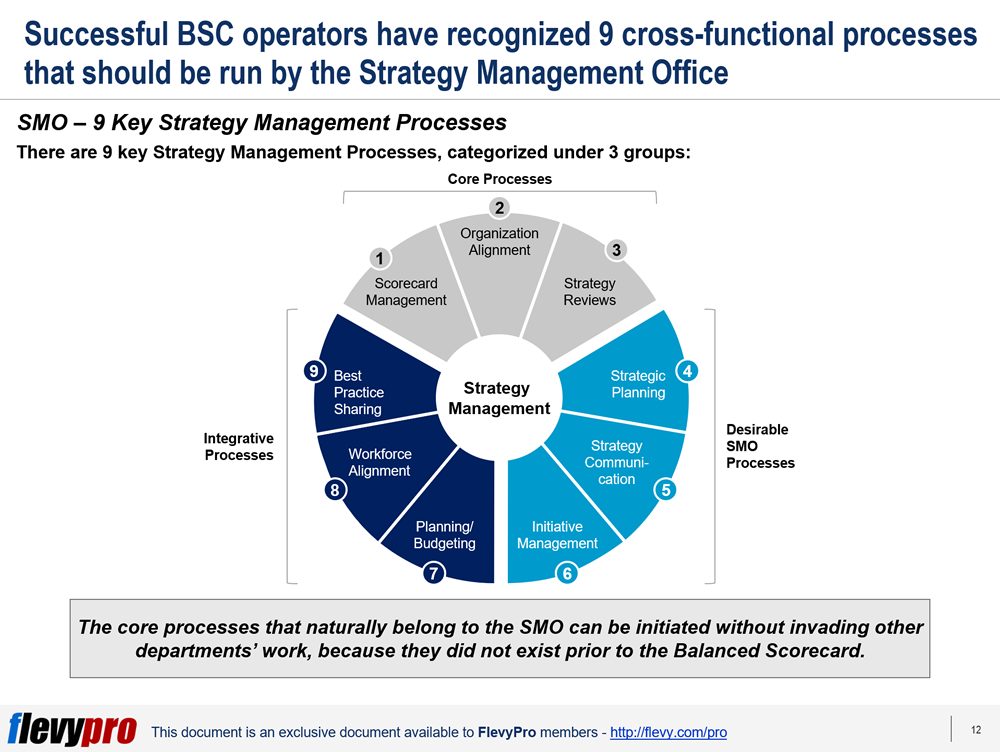Editor's Note: Take a look at our featured best practice, Strategic Planning: Hoshin Kanri (Hoshin Planning) (153-slide PowerPoint presentation). [NOTE: Our Hoshin Kanri presentation has been trusted by an array of prestigious organizations, including industry leaders such as Apple, Facebook, Boeing, Shell, Goodyear, Cummins, Johnson Controls, Hanes, Telefónica, Chubb, Discover, Stryker, Thales, Saint-Gobain, AGCO, to name just a [read more]
Also, if you are interested in becoming an expert on Strategy Development, take a look at Flevy's Strategy Development Frameworks offering here. This is a curated collection of best practice frameworks based on the thought leadership of leading consulting firms, academics, and recognized subject matter experts. By learning and applying these concepts, you can you stay ahead of the curve. Full details here.
* * * *
Most organizations struggle with Strategy execution. In fact, numerous studies from top consulting firms (including McKinsey, Bain, BCG) and Harvard Business Review have shown approximately 70% of strategies fail due to poor execution. Furthermore, organizations only realize about 60% of their strategies’ value.
Having a Strategic Management Office–i.e. SMO–may improve your chances of success. The SMO is the team responsible for managing the Corporate Strategy of the organization.
The ultimate role to execute Strategy lies with the line managers and employees. However, without a core command and coordination office (i.e. the SMO), Strategy is either skipped from key processes or the processes are ineffectual across business units, causing poor Strategy execution.
The high failure rate for Strategy execution can often be attributed to scattered and uncoordinated Strategy Management processes. Effective Strategy implementation necessitates synchronized efforts by different executive groups.
 The following describes how Strategic Management is performed at many organizations:
The following describes how Strategic Management is performed at many organizations:
- Strategy Development is typically performed by coordinating a meeting at an off-site location for the top team, doing a SWOT analysis in view of the changing circumstances and the information gathered since the last yearly Strategy gathering. These planning sessions are useful yet lack a clear and pragmatic framework to share the updated Strategy across the board.
- Individual departments issue their own annual Strategic Plans, and their strategies are hardly shared by the Corporate Strategy with other units. There is hardly any alignment between the various units and corporate strategies. The departmental plans do not aid corporate or business unit strategic initiatives.
- The Finance team’s annual budgeting process at year end is typically unaffected by the Strategic Plan; as most firms do not link their financial budgets to strategic priorities.
- Likewise, the Human Resources unit conducts annual performance reviews for all employees at the year end, but most of the managers and front-line people do not have rewards tied to successful Strategy implementation.
- Senior executives meet at least once a month during a year to review progress and initiate actions, but always get engaged in tactical issues and fire-fighting. Many leadership teams report spending less than an hour per month discussing their units’ Strategies.
Does this sound familiar?
The SMO provides the coordination and connection among these fragmented processes, as outlined above. More specifically, the SMO should manage 9 cross-functional processes, depicted below.

These 9 processes are categorized into 3 groups.
1. Core Processes
All the Core Processes must be run by the SMO.
- Scorecard Management – Design and report on the Balanced Scorecard (BSC) measures. For more resources on BSC, refer to these best practice documents from Flevy (here).
- Organization Alignment – Ensure all business and support units are aligned with the strategy.
- Strategy Reviews – Shape the agenda for management strategy review and learning meetings.
2. Desirable SMO Processes
These processes are performed by existing organizational units. These processes should eventually be incorporated into a central organization with strategic focus.
- Strategic Planning – Help the CEO and executive team formulate and adapt the strategy. For an in-depth discussion on Strategic Planning, check out our article (here).
- Strategy Communication – Communicate and educate employees about the strategy.
- Initiative Management – Identify and oversee management of strategic initiatives.
3. Integrative Processes
The integrative processes fall under the natural domain of other functions where the SMO plays a coordinating role, ensuring that the processes are closely incorporated with the enterprise Strategy.
- Planning/Budgeting – Link financial, human resources, information technology, and marketing to strategy.
- Workforce Alignment – Ensure all employee’s goals, incentives and development plans link to strategy.
- Best Practice Sharing – Facilitate a process to identify and share best practices.
Interested in setting up a Strategic Management Office (SMO)? We have a series of frameworks on SMO:
In establishing an SMO, organizations should recognize the transformative potential this structure brings. Beyond merely coordinating strategic efforts, the SMO acts as a catalyst for embedding a strategic mindset across all levels of the organization.
This alignment ensures that every department’s initiatives are not only synchronized with the overall Corporate Strategy, but also dynamically responsive to market changes and internal performance insights. As the business environment grows increasingly complex and competitive, the ability of the SMO to provide a cohesive, agile strategic framework becomes a critical differentiator for sustained success.
Moreover, the strategic oversight provided by the SMO fosters a culture of continuous improvement and innovation. By systematically reviewing performance metrics and facilitating cross-functional collaboration, the SMO encourages teams to consistently seek out and implement new ideas. This proactive stance ensures the organization remains competitive and forward-thinking in a rapidly evolving market landscape.
Further, by centralizing strategy management, the SMO enables a systematic approach to identifying and scaling best practices across the organization, thereby enhancing operational efficiencies and driving value creation. This centralization also supports better resource allocation, ensuring that strategic priorities receive the necessary attention and investment.
In turn, this comprehensive approach to strategy execution not only mitigates risks associated with fragmented processes, but also enhances the organization’s capacity to achieve its long-term objectives and adapt to emerging challenges.
Do You Find Value in This Framework?
You can download in-depth presentations on this and hundreds of similar business frameworks from the FlevyPro Library. FlevyPro is trusted and utilized by 1000s of management consultants and corporate executives.

48-slide PowerPoint presentation
Most frameworks, guides, and business gurus that discuss corporate strategy focus purely on the theory of great strategy, but don't teach the art of great execution. Without execution, strategy is merely theory.
In fact, a common complaint of strategy consulting firms is that they leave clients
[read more]
Want to Achieve Excellence in Strategy Development?
Gain the knowledge and develop the expertise to become an expert in Strategy Development. Our frameworks are based on the thought leadership of leading consulting firms, academics, and recognized subject matter experts. Click here for full details.
"Strategy without Tactics is the slowest route to victory. Tactics without Strategy is the noise before defeat." - Sun Tzu
For effective Strategy Development and Strategic Planning, we must master both Strategy and Tactics. Our frameworks cover all phases of Strategy, from Strategy Design and Formulation to Strategy Deployment and Execution; as well as all levels of Strategy, from Corporate Strategy to Business Strategy to "Tactical" Strategy. Many of these methodologies are authored by global strategy consulting firms and have been successfully implemented at their Fortune 100 client organizations.
These frameworks include Porter's Five Forces, BCG Growth-Share Matrix, Greiner's Growth Model, Capabilities-driven Strategy (CDS), Business Model Innovation (BMI), Value Chain Analysis (VCA), Endgame Niche Strategies, Value Patterns, Integrated Strategy Model for Value Creation, Scenario Planning, to name a few.
Learn about our Strategy Development Best Practice Frameworks here.
Readers of This Article Are Interested in These Resources

138-slide PowerPoint presentation
Our Strategic Planning Process, based on Hoshin Policy Deployment, provides an organization with proven and effective methods to develop, communicate and align its strategic goals, objectives, and initiatives.
The Strategic Planning - Hoshin Policy Deployment Training Module includes:
1. MS
[read more]

34-slide PowerPoint presentation
What is the Balanced Scorecard (BSC)?
The Balanced Scorecard is a strategy performance management tool--a semi-standard structured report, supported by proven design methods and automation tools, that can be used by managers to keep track of the execution of activities by the staff within their
[read more]

24-slide PowerPoint presentation
The Strategy Management Office (SMO), also referred sometimes as the Office of Strategy Management (OSM), is the team responsible for managing the Corporate Strategy of the organization.
The ultimate role to execute Strategy lies with the line managers and employees, but without a core command
[read more]

24-slide PowerPoint presentation
The Strategy Management Office (SMO), also referred sometimes as the Office of Strategy Management (OSM), is the team responsible for managing the Corporate Strategy of the organization.
The ultimate role to execute Strategy lies with the line managers and employees, but without a core command
[read more]
 The following describes how Strategic Management is performed at many organizations:
The following describes how Strategic Management is performed at many organizations:




